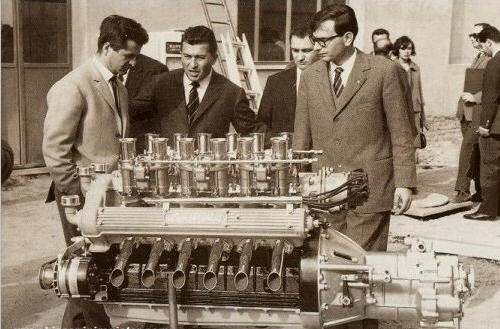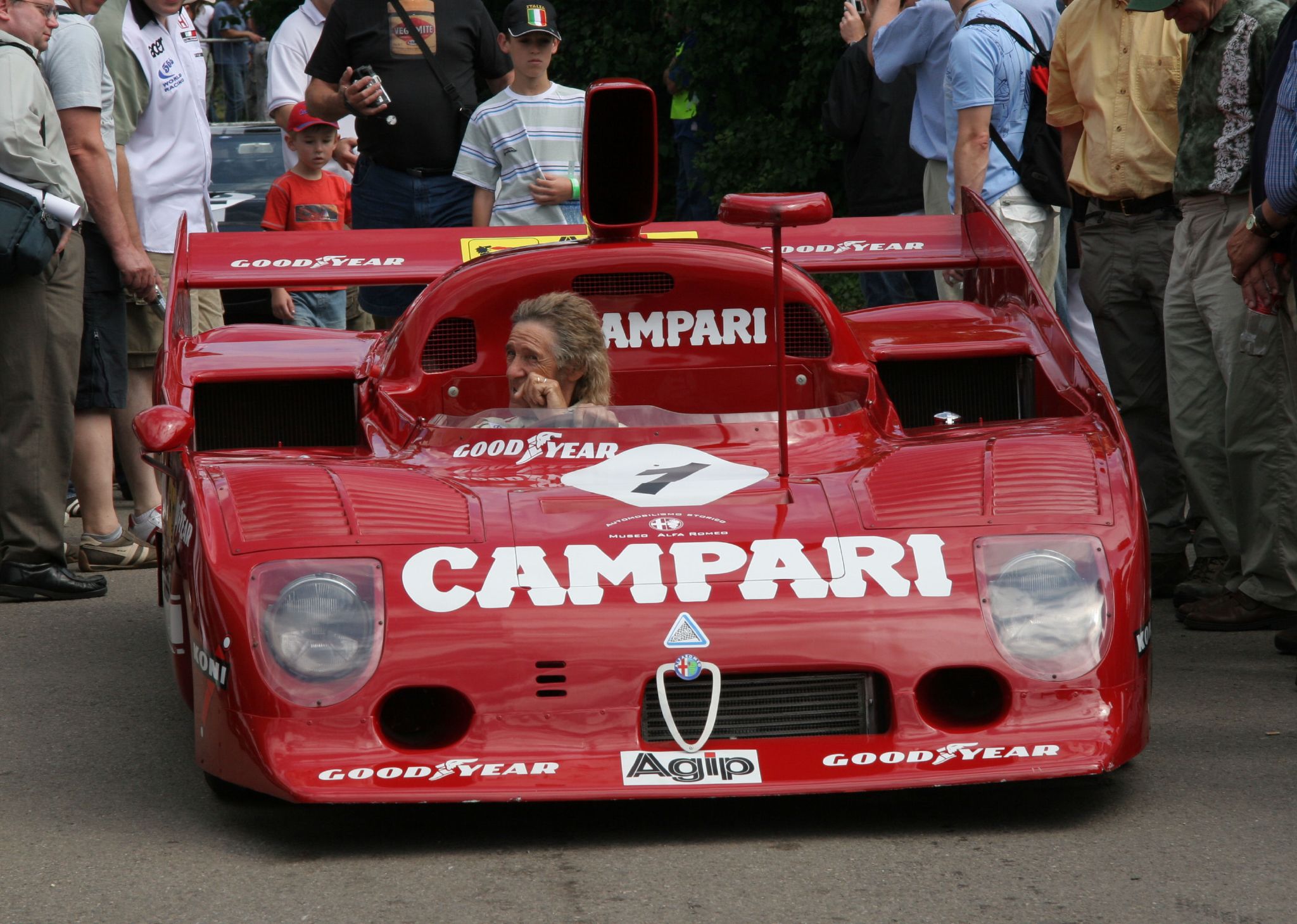|
Carlo Chiti
Carlo Chiti (19 December 1924 – 7 July 1994) was an Italian racing car and engine designer best known for his long association with Alfa Romeo's racing department. He also worked for Ferrari and was involved in the design of the Ferrari 156 Sharknose car, with which Phil Hill won the 1961 championship. Early life Born in Pistoia, Tuscany, Chiti graduated with a degree in aeronautical engineering from the University of Pisa in Italy in 1953. Motorsport career Chiti joined Alfa Romeo in 1952 and designed the Alfa Romeo 3000 CM sports car. When Alfa Romeo's competition department was closed down in the late 1950s Chiti was invited to join Scuderia Ferrari. At Ferrari Chiti was involved with the design of the 1958 championship winning car Ferrari 246 F1 together with Vittorio Jano and the Ferrari 156 Sharknose car, with which Phil Hill won the 1961 championship. He also mentored a new generation of aspiring designers who had begun a period of apprenticeship at the team, ... [...More Info...] [...Related Items...] OR: [Wikipedia] [Google] [Baidu] |
Giotto Bizzarrini
Giotto Bizzarrini (born 6 June 1926 in Quercianella, Livorno Province, Italy) is an Italian automobile engineer who was active from the 1950s through the 1970s. After graduating in 1953, Bizzarrini eventually joined Alfa Romeo as a test driver. He gained a reputation for identifying and solving problems and was head hunted by Ferrari in 1957. Bizzarrini's responsibility increased until he became sports car development chief at Ferrari in the late 1950s, working on such notable projects as the Ferrari 250 GTO. He split from the company as part of the 'Great Walkout' in 1961, worked first with ATS, and then in 1962 started his own company, Società Autostar, whose name was changed to Bizzarrini in 1964. In addition to producing the exotic Bizzarrini 5300 GT, Bizzarrini also worked for other makers including Iso, Lamborghini, and Alfa Romeo. Several concept cars in the 2000s bear his name. Early life Bizzarrini was the son of a rich landowner from Livorno. His grandfather ... [...More Info...] [...Related Items...] OR: [Wikipedia] [Google] [Baidu] |
1978 Formula One Season
The 1978 Formula One season was the 32nd season of FIA Formula One motor racing. It featured the 1978 World Championship of F1 Drivers and the International Cup for F1 Constructors,''World Championship of F1 Drivers 1978'' & ''International Cup for F1 Constructors 1978'', 1979 FIA Yearbook, Grey section, pages 86–87 contested concurrently over a sixteen race series which commenced on 15 January and ended on 8 October. The season also included the non-championship BRDC International Trophy. Mario Andretti won the Drivers' World Championship, driving for JPS-Lotus. He remains the last American driver to win the World Championship. His victory at the Dutch Grand Prix is also the last for an American driver. Ronnie Peterson was awarded second place in the Drivers' standings posthumously, having died from medical complications after an accident at Monza during the Italian Grand Prix. JPS-Lotus won the International Cup for F1 Constructors. Championship defendants Niki Lauda an ... [...More Info...] [...Related Items...] OR: [Wikipedia] [Google] [Baidu] |
Brabham BT46
The Brabham BT46 is a Formula One racing car designed by Gordon Murray for the Brabham team, owned by Bernie Ecclestone, for the 1978 Formula One season. The car featured several radical design elements, one of which was the use of flat panel heat exchangers on the bodywork of the car to replace conventional water and oil radiators. It was removed before the car's race debut, never to be seen again. The cars, however, powered by a flat-12 Alfa Romeo engine, raced competitively with modified nose-mounted radiators for most of the year, driven by Niki Lauda and John Watson, winning one race in this form and scoring sufficient points for the team to finish third in the constructors championship. The "B" variant of the car, also known as the "fan car", was introduced at the 1978 Swedish Grand Prix as a counter to the dominant ground-effect Lotus 79. The BT46B generated an immense amount of downforce by means of a fan, claimed to be for increased cooling, but which also extra ... [...More Info...] [...Related Items...] OR: [Wikipedia] [Google] [Baidu] |
Niki Lauda
Andreas Nikolaus "Niki" Lauda (22 February 1949 – 20 May 2019) was an Austrian Formula One driver and aviation entrepreneur. He was a three-time Formula One World Drivers' Champion, winning in , and , and is the only driver in Formula One history to have been champion for both Ferrari and McLaren, two of the sport's most successful constructors. He was an aviation entrepreneur who founded and ran three airlines: Lauda Air, Niki and Lauda. He was also a consultant for Scuderia Ferrari and team manager of the Jaguar Formula One racing team for two years. Afterwards, he worked as a pundit for German TV during Grand Prix weekends and acted as non-executive chairman of Mercedes-AMG Petronas Motorsport, of which Lauda owned 10%. Lauda emerged as Formula One's star driver amid a title win and leading the championship battle. Lauda was seriously injured in a crash at the 1976 German Grand Prix while racing at the Nürburgring; during the crash his Ferrari 312T2 bu ... [...More Info...] [...Related Items...] OR: [Wikipedia] [Google] [Baidu] |
Brabham
Brabham () is the common name for Motor Racing Developments Ltd., a British racing car manufacturer and Formula One racing team. Founded in 1960 by Australian driver Jack Brabham and British-Australian designer Ron Tauranac, the team won four Drivers' and two Constructors' World Championships in its 30-year Formula One history. Jack Brabham's 1966 FIA Drivers' Championship remains the only such achievement using a car bearing the driver's own name. In the 1960s, Brabham was the world's largest manufacturer of open-wheel racing cars for sale to customer teams; by 1970 it had built more than 500 cars. During this period, teams using Brabham cars won championships in Formula Two and Formula Three. Brabham cars also competed in the Indianapolis 500 and in Formula 5000 racing. In the 1970s and 1980s, Brabham introduced such innovations as in-race refuelling, carbon brakes, and hydropneumatic suspension. Its unique Gordon Murray-designed "fan car" won its only race before b ... [...More Info...] [...Related Items...] OR: [Wikipedia] [Google] [Baidu] |
1977 World Championship For Sports Cars
The 1977 World Sports Car Championship season was the 25th season of FIA World Sportscar Championship motor racing. It featured two separate World Championship series.Results, Automobile Year 1977/78, pages 196 to 223 * The 1977 World Championship for Sports Cars,International Championship Regulations 1977, 1977 FIA Yearbook, page 11 which was contested by Group 6 Two-Seater Racing Cars * The 1977 World Championship for Makes, which was open to cars from various production-based categories including Group 5 Special Production Cars In 1978 the World Championship of Makes would become the sole international series, while the World Championship for Sports Cars would be downgraded by the FIA to become the European Sportscar Championship. The European Championship was discontinued at the end of the 1978 season. World Championship for Sports Cars The 1977 World Championship for Sports Cars, which was restricted to Group 6 Two-Seater Racing Cars, was contested over an eight race seri ... [...More Info...] [...Related Items...] OR: [Wikipedia] [Google] [Baidu] |
1975 World Sportscar Championship Season
The 1975 World Sportscar Championship season was the 23rd season of FIA World Sportscar Championship motor racing. It featured the 1975 World Championship for Makes1976 FIA Yearbook, Grey section, pages 91-93 which was open to Group 5 Sports Cars and Group 4 Special GT Cars. It also included the FIA Cup for GT Cars and the FIA Cup for 2-Litre Cars. The three titles were contested concurrently over a nine race series which ran from 1 February to 12 July 1975. Schedule † Due to a lack of Group 5 entries, the FIA initially rescinded the championship status of the Daytona race. Several months after the event the FIA retroactively conferred championship status to the race and placed cars into the classes they would theoretically have entered. Season results Races World Championship for Makes Points towards the World Championship for Makes were awarded to the top 10 positions in each race in the order of 20-15-12-10-8-6-4-3-2-1.Peter Higham, The Guinness Guide to Internation ... [...More Info...] [...Related Items...] OR: [Wikipedia] [Google] [Baidu] |
Alfa Romeo Tipo 33
The Alfa Romeo Tipo 33 was a sports racing prototype raced by the Alfa Romeo factory-backed team between 1967 and 1977. These cars took part for Sport Cars World Championship, Nordic Challenge Cup, Interserie and CanAm series. A small number of road going cars were derived from it in 1967, called Alfa Romeo 33 Stradale. With the 33TT12 Alfa Romeo won the 1975 World Championship for Makes, and with the 33SC12 the 1977 World Championship for Sports Cars, taking the first place in all eight of the championship races. Alfa Romeo Tipo 33 Alfa Romeo started development of the Tipo 33 in the early 1960s, with the first car being built in 1965. It was sent to Autodelta to be completed and for additional changes to be made. It used a straight-4 engine from the Alfa Romeo TZ2, but Autodelta produced its 2.0 litre V8 soon after. The 2000 cc (122ci) Tipo 33 mid-engined prototype debuted on 12 March 1967 at the Belgian hillclimbing event at Fléron, with Teodoro Zeccoli winning ... [...More Info...] [...Related Items...] OR: [Wikipedia] [Google] [Baidu] |
Flat-twelve Engine
A flat-twelve engine, also known as a horizontally opposed-twelve, is a twelve-cylinder piston engine with six cylinders on each side of a central crankshaft. Flat-twelve engines are less common than V12 engines, but they have been used in various racing cars during the 1960s and 1970s, and in mid-engined Ferrari road cars from 1973 to 1996. Design Unlike most flat-twin, flat-four, and flat-six engines, flat-twelve engines typically use the crankshaft configuration of a 180° V engine. Instead of the boxer engine design of each piston having its own crankpin, flat-twelve engines have each pair of pistons sharing a crankpin, and thus are flat, but not boxers. Compared with a V12 engine, a flat-twelve has a lower center of gravity, but because a flat-twelve is wider it is rarely used in front-engined cars. Racing cars Formula One The first known flat-twelve engine was built by Porsche in 1947 for the abandoned Cisitalia Grand Prix racing car. The engine, known as the Porsch ... [...More Info...] [...Related Items...] OR: [Wikipedia] [Google] [Baidu] |
V8 Engine
A V8 engine is an eight- cylinder piston engine in which two banks of four cylinders share a common crankshaft and are arranged in a V configuration. The first V8 engine was produced by the French Antoinette company in 1904, developed and used in cars and speedboats but primarily aircraft; while the American 1914–1935 ''Cadillac L-Head'' engine is considered the first road going V8 engine to be mass produced in significant quantities. The popularity of V8 engines in cars was greatly increased following the 1932 introduction of the ''Ford Flathead V8''. In the early 21st century, use of V8 engines in passenger vehicles declined as automobile manufacturers opted for more fuel efficient, lower capacity engines, or hybrid and electric drivetrains. Design V-angle The majority of V8 engines use a V-angle (the angle between the two banks of cylinders) of 90 degrees. This angle results in good engine balance, which results in low vibrations; however, the downside is a ... [...More Info...] [...Related Items...] OR: [Wikipedia] [Google] [Baidu] |








